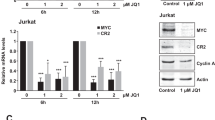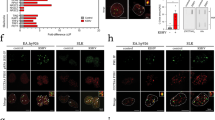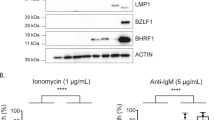Abstract
Primary effusion lymphoma (PEL) is a rare subtype of non-Hodgkin's lymphoma, which is associated with infection by Kaposi's sarcoma herpesvirus (KSHV)/human herpesvirus-8. The c-Myc transcription factor plays an important role in cellular proliferation, differentiation and apoptosis. Lymphomas frequently have deregulated c-Myc expression owing to chromosomal translocations, amplifications or abnormal stabilization. However, no structural abnormalities were found in the c-myc oncogene in PEL. Given that c-Myc is often involved in lymphomagenesis, we hypothesized that it is deregulated in PEL. We report that PEL cells have abnormally stable c-Myc protein. The turnover of c-Myc protein is stringently regulated by post-transcriptional modifications, including phosphorylation of c-Myc threonine 58 (T58) by glycogen synthase kinase-3β (GSK-3β). Our data show that the impaired c-Myc degradation in PEL cells is associated with a significant underphosphorylation of c-Myc T58. The KSHV latency-associated nuclear antigen (LANA) is responsible for this deregulation. Overexpression of LANA in human embryonic kidney 293 or peripheral blood B cells leads to post-transcriptional deregulation of c-Myc protein. Conversely, when LANA is eliminated from PEL cells using RNA interference, GSK-3β-mediated c-Myc T58 phosphorylation is restored. The presence of c-Myc and LANA in GSK-3β-containing complexes in PEL cells further confirms the significance of these interactions in naturally KSHV-infected cells.
This is a preview of subscription content, access via your institution
Access options
Subscribe to this journal
Receive 50 print issues and online access
$259.00 per year
only $5.18 per issue
Buy this article
- Purchase on Springer Link
- Instant access to full article PDF
Prices may be subject to local taxes which are calculated during checkout






Similar content being viewed by others
References
An FQ, Compitello N, Horwitz E, Sramkoski M, Knudsen ES, Renne R . (2005). The latency-associated nuclear antigen of Kaposi's sarcoma-associated herpesvirus modulates cellular gene expression and protects lymphoid cells from p16 INK4A-induced cell cycle arrest. J Biol Chem 280: 3862–3874.
An J, Sun Y, Rettig MB . (2004). Transcriptional coactivation of c-Jun by the KSHV-encoded LANA. Blood 103: 222–228.
Arvanitakis L, Mesri EA, Nador R, Said JW, Asch AS, Knowles DM et al. (1996). Establishment and characterization of a primary effusion (body cavity-based) lymphoma cell line (BC-3) harboring Kaposi’s sarcoma-associated herpesvirus (KSHV/HHV-8) in the absence of Epstin–Barr virus. Blood 88: 2648–2654.
Ballestas ME, Chatis PA, Kaye KM . (1999). Efficient persistence of extrachromosomal KSHV DNA mediated by latency-associated nuclear antigen. Science 284: 641–644.
Bhatia K, Huppi K, Spangler G, Siwarski D, Iyer R, Magrath I . (1993). Point mutations in the c-Myc transactivation domain are common in Burkitt’s lymphoma and mouse plasmacytomas. Nat Genet 5: 56–61.
Bijur GN, Jope RS . (2003). Glycogen synthase kinase-3 beta is highly activated in nuclei and mitochondria. Neuroreport 14: 2415–2419.
Cadigan KM, Nusse R . (1997). Wnt signaling: a common theme in animal development. Genes Dev 11: 3286–3305.
Cesarman E, Chang Y, Moore PS, Said JW, Knowles DM . (1995a). Kaposi’s sarcoma-associated herpesvirus-like DNA sequences in AIDS-related body cavity-based lymphomas. N Engl J Med 332: 1186–1191.
Cesarman E, Dalla-Favera R, Bentley D, Groudine M . (1987). Mutations in the first exon are associated with altered transcription of c-myc in Burkitt lymphoma. Science 238: 1272–1275.
Cesarman E, Moore PS, Rao P, Inghirami G, Knowles DM, Chang Y . (1995b). In vitro establishment and characterization of two acquired immunodeficiency syndrome-related lymphoma cell lines (BC-1 and BC-2) containing Kaposi's sarcoma-associated herpesvirus-like (KSHV) DNA sequences. Blood 86: 2708–2714.
Chang DW, Claassen GF, Hann SR, Cole MD . (2000). The c-Myc transactivation domain is a direct modulator of apoptotic versus proliferative signals. Mol Cell Biol 20: 4309–4319.
Conzen SD, Gottlob K, Kandel ES, Khanduri P, Wagner AJ, O’Leary M et al. (2000). Induction of cell cycle progression and acceleration of apoptosis are two separable functions of c-Myc: transrepression correlates with acceleration of apoptosis. Mol Cell Biol 20: 6008–6018.
Dalla-Favera R, Bregni M, Erickson M, Patterson D, Gallo RC, Croce CM . (1982). Human c-myc oncogene is located on the region of chromosome 8 that is translocated in Burkitt lymphoma cells. Proc Natl Acad Sci 79: 7824–7827.
Dominguez-Sola D, Dalla-Favera R . (2004). PINning down the c-Myc oncoprotein. Nat Cell Biol 6: 288–289.
Fakhari FD, Jeong JH, Kanan Y, Dittmer DP . (2006). The latency-associated nuclear antigen of Kaposi sarcoma-associated herpesvirus induces B cell hyperplasia and lymphoma. J Clin Invest 116: 735–742.
Fan W, Bubman D, Chadburn A, Harrington Jr WJ, Cesarman E, Knowles DM . (2005). Distinct subsets of primary effusion lymphoma can be identified based on their cellular gene expression profile and viral association. J Virol 79: 1244–1251.
Friborg Jr J, Kong W, Hottiger MO, Nabel GJ . (1999). p53 inhibition by the LANA protein of KSHV protects against cell death. Nature 402: 889–894.
Fujimuro M, Wu FY, ApRhys C, Kajumbula H, Young DB, Hayward GS et al. (2003). A novel viral mechanism for dysregulation of beta-catenin in Kaposi's sarcoma-associated herpesvirus latency. Nat Med 9: 300–306.
Gaidano G, Pasqualucci L, Capello D, Berra E, Deambrogi C, Rossi D et al. (2003). Aberrant somatic hypermutation in multiple subtypes of AIDS-associated non-Hodgkin lymphoma. Blood 102: 1833–1841.
Gaidano G, Pastore C, Gloghini A, Volpe G, Ghia P, Saglio G et al. (1996). AIDS-related non-Hodgkins lymphomas: molecular genetics, viral infection and cytokine deregulation. Acta Haematol 95: 193–198.
Grandori C, Eisenman RN . (1997). Myc target genes. Trends Biochem Sci 22: 177–181.
Gregory MA, Hann SR . (2000). c-Myc proteolysis by the ubiquitin-proteasome pathway: stabilization of c-Myc in Burkitt's lymphoma cells. Mol Cell Biol 20: 2423–2435.
Gregory MA, Qi Y, Hann SR . (2003). Phosphorylation by glycogen synthase kinase-3 controls c-myc proteolysis and subnuclear localization. J Biol Chem 278: 51606–51612.
Hann SR, Eisenman RN . (1984). Proteins encoded by the human c-myc oncogene: differential expression in neoplastic cells. Mol Cell Biol 4: 2486–2497.
Hayward SD, Liu J, Fujimuro M . (2006). Notch and Wnt signaling: mimicry and manipulation by gamma herpesviruses. Sci STKE 2006 335: re4.
Henriksson M, Luscher B . (1996). Proteins of the Myc network: essential regulators of cell growth and differentiation. Adv Cancer Res 68: 109–182.
Henriksson M, Bakardjiev A, Klein G, Luscher B . (1993). Phosphorylation sites mapping in the N-terminal domain of c-myc modulate its transforming potential. Oncogene 8: 3199–3209.
Horenstein MG, Nador RG, Chadburn A, Hyjek EM, Inghirami G, Knowles DM et al. (1997). Epstein–Barr virus latent gene expression in primary effusion lymphomas containing Kaposi’s sarcoma-associated herpesvirus human herpesvirus-8. Blood 90: 1186–1191.
Jope RS, Johnson GV . (2004). The glamour and gloom of glycogen synthase kinase-3. Trends Biochem Sci 29: 95–102.
King MW, Roberts JM, Eisenman RN . (1986). Expression of the c-myc proto-oncogene during development of Xenopus laevis. Mol Cell Biol 6: 4499–4508.
Knight JS, Cotter MA, Robertson ES . (2001). The latency-associated nuclear antigen of Kaposi's sarcoma-associated herpesvirus transactivates the telomerase reverse transcriptase promoter. J Biol Chem 276: 22971–22978.
Livak KJ, Schmittgen TD . (2001). Analysis of relative gene expression data using real-time quantitative PCR and the 2(-Delta Delta C(T)) method. Methods 25: 402–408.
Moore PS, Chang Y . (1995). Detection of herpesvirus-like DNA sequences in Kaposi’s sarcoma lesions from persons with and without HIV infection. N Engl J Med 332: 1181–1185.
Nador RG, Cesarman E, Chadburn A, Dawson DB, Ansari MQ, Said J et al. (1996). Primary effusion lymphoma: a distinct clinicopathologic entity associated with the Kaposi's sarcoma-associated herpesvirus. Blood 88: 645–656.
Papas TS, Lautenberger JA . (1985). Sequence curiosity in v-myc oncogene. Nature 318: 237.
Pelengaris S, Khan M . (2003). The many faces of c-MYC. Arch Biochem Biophys 416: 129–136.
Pelengaris S, Khan M, Evan G . (2002a). c-MYC: more than just a matter of life and death. Nat Rev Cancer 2: 764–776.
Pelengaris S, Khan M, Evan GI . (2002b). Suppression of Myc-induced apoptosis in beta cells exposes multiple oncogenic properties of Myc and triggers carcinogenic progression. Cell 109: 321–334.
Polakis P . (2000). Wnt signaling and cancer. Genes Dev 14: 1837–1851.
Pulverer BJ, Fisher C, Vousden K, Littlewood T, Evan G, Woodgett JR . (1994). Site-specific modulation of c-Myc cotransformation by residues phosphorylated in vivo. Oncogene 9: 59–70.
Rabbitts TH, Hamlyn PH, Baer R . (1983). Altered nucleotide sequences of a translocated c-myc gene in Burkitt lymphoma. Nature 306: 760–765.
Radkov SA, Kellam P, Boshoff C . (2000). The latent nuclear antigen of kaposi sarcoma-associated herpesvirus targets the retinoblastoma-E2F pathway and with the oncogene hras transforms primary rat cells. Nat Med 6: 1121–1127.
Rao PH, Houldsworth J, Dyomina K, Parsa NZ, Cigudosa JC, Louie DC et al. (1998). Chromosomal and gene amplification in diffuse large B-cell lymphoma. Blood 92: 234–240.
Renne R, Barry C, Dittmer D, Compitello N, Brown PO, Ganem D . (2001). Modulation of cellular and viral gene expression by the latency- associated nuclear antigen of Kaposi’s sarcoma-associated herpesvirus. J Virol 75: 458–468.
Renne R, Zhong W, Herndier B, McGrath M, Abbey N, Kedes D et al. (1996). Lytic growth of Kaposi's sarcoma-associated herpesvirus (human herpesvirus 8) in culture. Nat Med 2: 342–346.
Sears R, Nuckolls F, Haura E, Taya Y, Tamai K, Nevins JR . (2000). Multiple Ras-dependent phosphorylation pathways regulate Myc protein stability. Genes Dev 14: 2501–2514.
Soulier J, Grollet L, Oksenhendler E, Cacoub P, Cazals-Hatem D, Babinet P et al. (1995). Kaposi’s sarcoma-associated herpesvirus-like DNA sequences in multicentric Castleman's disease. Blood 86: 1275–1280.
Taub R, Kirsch I, Morton C, Lenoir G, Swan D, Tronick S et al. (1982). Translocation of the c-myc gene into the immunoglobulin heavy chain locus in human Burkitt lymphoma and murine plasmacytoma cells. Proc Natl Acad Sci USA 79: 7837–7841.
Yano T, Sander CA, Clark HM, Dolezal MV, Jaffe ES, Raffeld M . (1993). Clustered mutations in the second exon of the MYC gene in sporadic Burkitt’s lymphoma. Oncogene 8: 2741–2748.
Yeh E, Cunningham M, Arnold H, Chasse D, Monteith T, Ivaldi G et al. (2004). A signalling pathway controlling c-Myc degradation that impacts oncogenic transformation of human cells. Nat Cell Biol 6: 308–318.
Acknowledgements
We thank Rosalie Sears for invaluable advice about the details of c-Myc experiments. This work was supported by NIH Grant R01 CA068939, by a Leukemia and Lymphoma Society Translational Research Program Grant and by an Irma T Hirschl/Monique Weill-Caulier Career Scientist Award to EC.
Author information
Authors and Affiliations
Corresponding author
Additional information
Supplementary Information accompanies the paper on the Oncogene website (http://www.nature.com/onc).
Supplementary information
Rights and permissions
About this article
Cite this article
Bubman, D., Guasparri, I. & Cesarman, E. Deregulation of c-Myc in primary effusion lymphoma by Kaposi's sarcoma herpesvirus latency-associated nuclear antigen. Oncogene 26, 4979–4986 (2007). https://doi.org/10.1038/sj.onc.1210299
Received:
Revised:
Accepted:
Published:
Issue Date:
DOI: https://doi.org/10.1038/sj.onc.1210299
Keywords
This article is cited by
-
Transmembrane protein GRINA modulates aerobic glycolysis and promotes tumor progression in gastric cancer
Journal of Experimental & Clinical Cancer Research (2018)
-
c-Myc and viral cofactor Kaposin B co-operate to elicit angiogenesis through modulating miRNome traits of endothelial cells
BMC Systems Biology (2016)
-
Targeting Myc in KSHV-associated primary effusion lymphoma with BET bromodomain inhibitors
Oncogene (2014)



